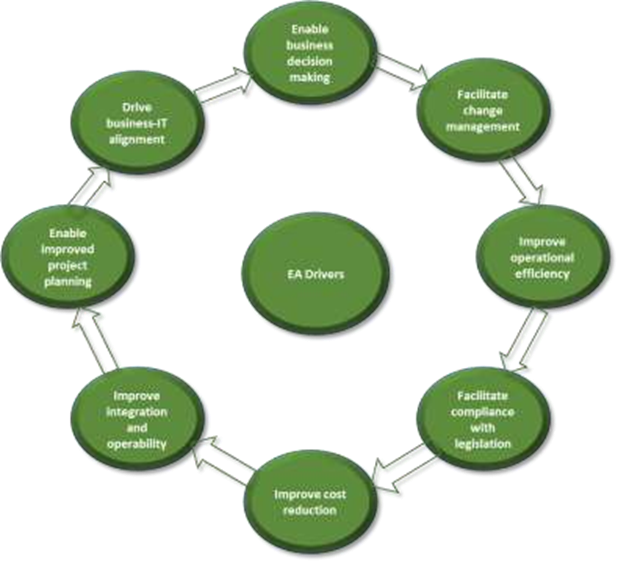Enterprise Architecture Drivers
Listed below are some of the business requirements and drivers that make a case for Enterprise Architecture.
- Legislation: - Legislations change frequently. An agile enterprise architecture ensures that organizations comply with changing legislation easily by imbedding legislation and rules into everyday business processes execution and technology enablement. It also follows that the requirement to comply with pieces of legislation has a direct influence on the type of service and process that an organization delivers.
- Government Mandate: - Acts of Parliament and government mandates must be complied with. These are some of the strongest drivers for enterprise architecture because they trigger specific processes.
- Strategic Goals (Business and IT Alignment): - Arguably the most important value of enterprise architecture is that it ensures the alignment of IT capabilities with business requirements. This is achieved through the seamless alignment of Business Architecture domain with the Information
- Systems Architecture and Technology domains (refer to Figure 4). ICT needs to align itself to the strategic goals of the organization.
- Enable decision making and change management: - Properly defined, documented, and implemented enterprise architecture will assist executives in making informed decisions by highlighting the relationships between various elements that work together in the delivery of services or products and showing what the impact of a change in any one of them would have on the other related elements.
- Improve Operational efficiency and productivity: - One of the key values to be derived from enterprise architecture is the ability to assist organizations in making changes that will streamline operations, reduce unwanted redundancies and optimize operational activities.
- Cost Reduction: - Agile enterprise architecture streamlines processes, people and technology to efficiently and profitably manage the delivery of services and products through process improvement, technology rationalization and portfolio management, and through effective definitions of roles and responsibilities
- Improved integration and operability: - As blueprints for each organization are being developed, entities will be able to see how best they can integrated with others within the same cluster. This is because the blueprints will show the landscape for each entity which will include the technologies and services. As such, common and related services will be made clearer and decisions on the use of specific technologies. The need for improved integration is therefore another important driver for enterprise architecture because the result is optimization of the use of available resources.
- Proper project planning: - By making the baseline (As Is) view of the enterprise clear, enterprise architecture enables better planning for projects as decisions makers are able to see not only the impact that a project would have, but also see and re-use what is already in the environment before a decision to either build or buy is made.


No Comments